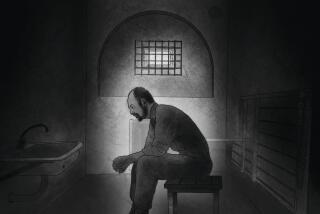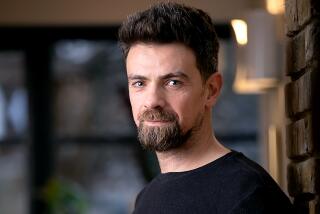Communist Roots Run Deep for the Children of the Gulag
MAGADAN, Soviet Union — On the doorstep of what a Jewish poet once called the “icy Auschwitz of the North,” the last thing a visitor expects to hear is nostalgia for the good old days of Soviet dictatorship.
After all, this place in the Soviet Far East has become infamous as the “last island” in the system of Stalinist prisons that the writer Alexander Solzhenitsyn called the Gulag Archipelago.
But the Siberian city of Magadan is 5,000 miles from the unfolding political drama in Moscow, and communism has grown deep roots here--even among children of those who suffered in the gulags.
A 30-foot statue of Vladimir I. Lenin, the Bolshevik leader who founded the Soviet state, still stands defiantly on a red marble plinth across a city plaza swept by Arctic winds nearly two months after Communist Party hard-liners staged an unsuccessful coup against President Mikhail S. Gorbachev.
“Before, we used to have everything,” said Lyubov Popova, an employee of the state supply organization. “Now, we have practically nothing.”
Popova’s complaint seems especially harsh because she was born 50 years ago in the “Kalyma,” a vast network of labor camps that spread hundreds of miles north into the Arctic along the Kalyma River in the 1930s and took the lives of more than a million innocent victims.
For Popova and other children of the gulag who remained behind in Magadan, the uncharted Soviet future now seems to hold as much terror as the demons of their past.
Popova spent her first eight years in a gulag camp, enduring cold and disease, and did not meet her mother until she was 4 years old. Even after she left the camps, Popova’s teachers would point her out to other students with the warning that she was a daughter of an “enemy of the people.”
Despite what are obviously painful memories, Popova reserved a trembling anger for the current state of profiteering by the Soviet Union’s growing brigade of private business people.
“What this country really needs is a strong dictator who can take these crooks out and shoot them,” she said coldly, biting off her words in an interview.
Zoya Sedova, 71, is another child of the gulag, whose parents began as revolutionaries under the czars and ended up being shipped off to the camps in 1937. Even today, Sedova finds herself choking back a sob as the 50-year-old vision of her mother being marched away in prison garb flickers briefly across the movie screen of her memory.
Despite her parents’ fate, Sedova went on to settle in Magadan, and she joined the Communist Party in 1951. She said she never associated the party--still led by the dictator Josef Stalin when she became a member--with oppression or the country’s ills.
“For me, everything that is good came in the name of the party,” Sedova explained over Georgian champagne and canned sardines. “The party gave me a college education, the party got me a job, the party gave me an apartment. . . . Now, without the party, we are all afraid about the future.”
Vera Gogoleva arrived in Magadan 46 years ago, searching for her father who had been a deputy director of the Communist Party in the Siberian city of Novosibirsk and was arrested for anti-party activity.
After she learned that her father had been executed in the camps, Gogoleva found work in Magadan and also joined the party herself. She said that far from facing a moral dilemma about becoming a party member, she had worried that because of her father’s imprisonment the party might decide not to admit her.
Now her life has been turned inside out again, with the party virtually dissolved after the attempted coup and the newspapers full of politics that, she admits, “I can’t understand.” A huge red banner reading “Long Live Marxism and Leninism” still decorates the wall of the building where Gogoleva teaches at an institute.
“It’s hard to say whether I still believe in the party or not,” Gogoleva said. “Life was much better in Magadan 30 years ago. Magadan really lived well.”
After the labor camps closed in the 1950s, most of the surviving inmates made their way home to European Russia.
But Magadan remained an important gold mining center for the Soviet Union, growing into a strategic city of 167,000 workers that remained closed to foreigners until last year.
Even Soviet citizens needed a special visa to visit the city, and the gold mines were so secret that newspaper reports referred to the output of the mines only as Metal No. 1.
The city was built largely by slave labor. Many former prisoner barracks remain, and residents still prize the apartments erected by Japanese prisoners of war because of the quality of the construction. On the outskirts of the city, jagged pieces of barbed wire and collapsed prison cells remain as grim reminders of the town’s history.
Because the government could no longer use outright force to get workers to settle in Magadan’s inhospitable terrain--an old joke says that Magadan has 12 months of winter, while the rest are summer--it resorted to bribery. Workers were paid a 70% monthly salary bonus to move here, and the city received far more food and other consumer goods then most other places.
Since the start of Gorbachev’s program of economic restructuring, however, material goods have dwindled, and the added salary bonus has become meaningless, with the Soviet ruble regarded as being next to worthless.
Magadan Mayor Gennady Doroseyev said the city hopes to start receiving a share of the profits of the gold mining operation with which to buy consumer goods.
But Doroseyev said that he remains a committed Communist and that he would never take down portraits of Lenin, including the one on the wall above his desk.
Because of the economic situation, Magadan has a hard time attracting new workers, especially teachers of subjects such as mathematics and English, while everyone with a skill who can find work elsewhere has departed.
“A lot of my friends have left Magadan in the last couple of years,” said Alexander Ovchinnikov, an employee of a new private tourism venture attempting to attract American visitors for gulag tours. During the summer months, Alaska Airlines makes a twice-weekly flight to the city.
Ovchinnikov’s grandfather was sent as a prisoner to Magadan in the 1940s for stirring up Ukrainian nationalism, and he decided to remain as administrator of the city’s tiny hospital. When the family finally moved away in the 1960s, Ovchinnikov grew homesick and returned.
“I really like it here,” Ovchinnikov said. “Every third person you meet comes from the family of a former prisoner. That’s why people are friendlier.”
There are no official records on the number of families of former prisoners now living in Magadan, but Igor Pavlov, a city official in charge of a rehabilitation committee, said the city has 220 registered survivors of the camps.
According to a number of former prisoners, the official count may be lower than the actual number, because it reflects only those survivors who have officially asked for compensation.
Asir Sandler, a linguist who has written a book about his experiences in the camps, said that many ex-prisoners would not apply for compensation, because they were still fearful of having their name on a list of inmates, anticipating that they might be arrested again.
When he heard about the coup attempt in August, Sandler said his first thought was that he would be arrested for writing about camp life and sent to a new camp.
“Fear is in our bones, and we can’t get rid of it,” Sandler said.
In a further twist to a system in which justice was unknown, of the hundreds of thousands of inmates released in the 1950s, only those inmates who were officially rehabilitated are entitled to government compensation.
Among former inmates such as Sandler and Popova, there is resentment that the Moscow-based group Memorial has raised a million rubles, about $600,000 at the commercial exchange rate, to erect a sculpture to those who died in the camps, while the survivors are largely ignored.
The sculpture was designed by Ernst Neizvestny, a prominent Russian emigre, who also designed the gravestone for Nikita S. Khrushchev, the Soviet leader who emptied most of the camps.
The former inmates are less nostalgic about the past. Nikolai Muller, 67, who was sent to the camps as a teen-ager in 1948, stayed in Magadan when he was released because he had no money or relatives to go home to.
“I had no chance to leave,” Muller said. “After 10 years in the camps, I was afraid of everything.”
Now, Muller hopes for revenge against his former jailers, whom he noted have never been punished despite the nature of their crimes. He was astonished several years ago to discover that the head of a forced labor camp had been appointed researcher at the Magadan museum.
Recently, Muller turned his wrath on the Communist Party, and he wants the local party leadership to be denounced as a criminal gang. Many important party figures, he said, have escaped legal investigation of their activities and used their connections to get high-paying jobs in industry.
“No one who was in the camps believes in the party,” Muller said. “We all hate the system that did this to us.”
More to Read
Sign up for Essential California
The most important California stories and recommendations in your inbox every morning.
You may occasionally receive promotional content from the Los Angeles Times.










